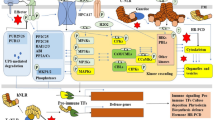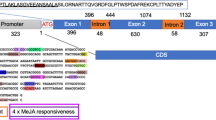Abstract
An S-receptor kinase (SRK) gene associated with self-incompatibility in a Brassica napus subsp. oleifera line has been characterized. The SRK-A14 cDNA shows the highest levels of homology in the 5′ end to the SLG-A14 cDNA present at the same locus. RNA blot analysis shows that the SRK-A14 gene is expressed predominantly in the pistil, and at lower levels in the anthers. The predicted amino acid sequences from the extracellular domain of the SRK-A14 gene and three other SRK genes were compared. The different SRK extracellular domains were for the most part very similar, with the exception of two variable regions containing a high level of amino acid alterations. These extracellular domains also contain a region of similarity to the immunoglobulin domains present in members of the immunoglobulin superfamily. These findings may define regions of the SRK protein that are necessary for interactions between SRK and other proteins.
Similar content being viewed by others
References
Amzel LM, Polijak RJ (1979) Three dimensional structure of Igs. Annu Rev Biochem 48:961–997
Bateman AJ (1955) Self-incompatibility systems in angiosperms. III Cruciferae. Heredity 9:53–68
Cantley LC, Auger KR, Carpenter C, Duckworth B, Graziani A, Kapeller R, Soltoff (1991) Oncogenes and signal transduction. Cell 64:281–302
Dayhoff MO, Barker WC, Hunt LT (1983) Establishing homologies in protein sequences. Methods Enzymol 91:524–545
Doolittle RF (1987) Of URFs and ORFs. University Science Books, Mill valley, USA
Doolittle RF (1988) Similar amino acid sequences: chance or common ancestry? Science 214:149–159
Dwyer KG, Balent MA, Nasrallah JB, Nasrallah ME (1991) DNA sequences of self-incompatibility genes from Brassica campestris and B. oleracea: polymorphism predating speciation. Plant Mol Biol 16:481–486
Fedoroff N, Mauvais J, Chaleff D (1983) Molecular studies on mutations at the shrunken locus in maize caused by the controlling elements Ds. J Mol Appl Genet 2:11–29
Frohman MA, Dush MK, Matin GR (1988) Rapid production of full-length cDNAs from rare transcripts: Amplification using a single gene-specific oligonucleotide primer. Proc Natl Acad Sci USA 85:8998–9002
Gold DP, Clevers H, Alarcon B, Dunlap S, Novotny J, Williams AF, Terhorst C (1987) Evolutionary relationship between the T3 chains of the T cell receptor complex and the Ig supergene gamily. Proc Natl Acad Sci USA 84:7649–7653
Goring DR, Rothstein SJ (1993) The S-locus receptor kinase gene in a self-incompatible Brassica napus line encodes a functional serine/threonine kinase. Plant Cell 4:1273–1281
Goring DR, Banks P, Fallis L, Baszczynski CL, Beversdorf WD, Rothstein SJ (1992a) Identification of an S-locus glycoprotein allele introgressed from B. napus ssp. rapifera to B. napus ssp. oleifera. Plant J 2:983–989
Goring DR, Banks P, Beversdorf WD, Rothstein SJ (1992b) Use of the polymerase chain reaction to isolate an S-locus glycoprotein cDNA introgressed from Brassica campestris into B. napus spp. olifera. Mol Gen Genet 234:185–192
Goring DR, Glavin TL, Schafer U, Rothstein SJ (1993) An S-receptor kinase gene in self-compatible Brassica napus has a 1-bp deletion. Plant Cell 5:531–539
Hanks S, Quinn AM, Hunter T (1988) The protein kinase family: Conserved features and deduced phylogeny of the catalytic domains. Science 241:42–52
Harvey RJ, Darlison MG (1991) Random-primed cDNA synthesis facilitates the isolation of multiple 5′cDNA ends by RACE. Nucleic Acids Res. 19:4002
Hunkapiller T, Hood L (1989) Diversity of the immunoglobulin gene superfamily. Adv Immunol 44:1–63
Jones JDG, Dunsmuir P, Bedbrook J (1985) High level expression of introduced chimeric genes in regenerated transformed plants. EMBO J 4:2411–2418
Lai C, Brow MA, Nave KA, Noronha AB, Quarles RH, Bloom FE, Milner RJ, Sutcliffe JG (1987) Two forms of 1B235/myelin associated glycoprotein, a cell adhesion molecule produced by alternative splicing. Proc Natl Acad Sci USA 84:4337–4341
Mackay GR (1977) The introgression of S-alleles into forage rape Brassica napus L. from turnip Brassica campestris ssp. rapifera. Euphytica 26:511–519
Nasrallah JB, Goldberg ML, Nasrallah ME (1985) A cDNA clone encoding and S-locus-specific glycoprotein from Brassica oleracea. Nature 318:263–267
Nasrallah ME, Kandsamy MK, Nasrallah JB (1992) A genetically defined trans-acting locus regulates S-locus function in Brassica. Plant J 2:497–506
Ockendon DJ (1974) Distribution of self-incompatibility alleles and breeding structure of open-pollinated cultivars of Brussel sprouts. Heredity 33:159–171
Ockendon DJ (1982) An S-allele survey of cabbage (Brassica oleracea var. capitata). Euphytica 31:325–331
Oikawa S, Imajo S, Noguchi T, Kosake G, Nakazato H (1987) The carcinoembryonic antigen (CEA) contains multipe immunoglobulin-like domains. Biochem Biophys Res Commun 144:634–642
Stein JC, Nasrallah JB (1993) A plant receptor-like gene, the S-locus receptor kinase of Brassica oleracea L., encodes a functional serine/threonine kinase. Plant Physiol 101:1103–1106
Stein JC, Howlett B, Boyes DC, Nasrallah ME, Nasrallah JB (1991) Molecules cloning of a putative receptor protein kinase gene encoded at the self-incompatibility locus of Brassica oleracea. Proc Natl Acad Sci USA 88:8816–8820
Ullrich A, Schlessinger J (1990) Signal transduction by receptors with tyrosine kinase activity. Cell 61:203–212
Williams AF (1987) A year in the life of the immunoglobulin superfamily. Immunol Today 8:298–303
Williams AF, Barclay AN (1988) The immunoglobulin superfamily-domains for cell surface recognition. Annu Rev Immunol 6:381–405
Yarden Y, Escobedo JA, Kuang, WJ, Yang-Feng TL, Daniel TO, Tremble PM, Chen EY, Ando ME, Harkins RN, Francke U, Fried VA, Ullrich A, Williams LT (1986) Structure of the receptor for platelet-derived growth factor helps define a family of closely related growth factor receptors. Nature 3236:226–232
Author information
Authors and Affiliations
Additional information
Communicated by G. Melchers
Rights and permissions
About this article
Cite this article
Glavin, T.L., Goring, D.R., Schafer, U. et al. Features of the extracellular domain of the S-locus receptor kinase from Brassica . Molec. Gen. Genet. 244, 630–637 (1994). https://doi.org/10.1007/BF00282753
Received:
Accepted:
Issue Date:
DOI: https://doi.org/10.1007/BF00282753




